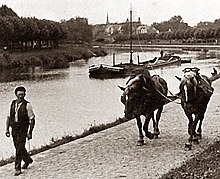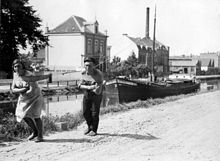
Back ممر السحب Arabic Camí de sirga Catalan Potahová stezka Czech Pramsti Danish Leinpfad German Haŭlvojo Esperanto Camino de sirga Spanish 曳舟道 Japanese 예선로 Korean Влечна патека Macedonian
The examples and perspective in this article may not represent a worldwide view of the subject. (July 2015) |






A towpath is a road or trail on the bank of a river, canal, or other inland waterway. The purpose of a towpath is to allow a land vehicle, beasts of burden, or a team of human pullers to tow a boat, often a barge. This mode of transport was common where sailing was impractical because of tunnels and bridges, unfavorable winds, or the narrowness of the channel.
After the Industrial Revolution, towing became obsolete when engines were fitted on boats and when railway transportation superseded the slow towing method. Since then, many of these towpaths have been converted to multi-use trails and footpaths. They are still named towpaths — although they are now only occasionally used for the purpose of towing boats.